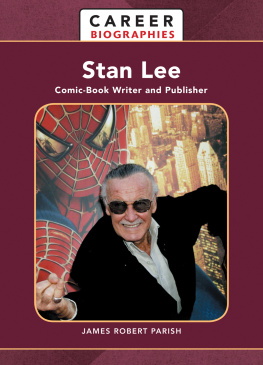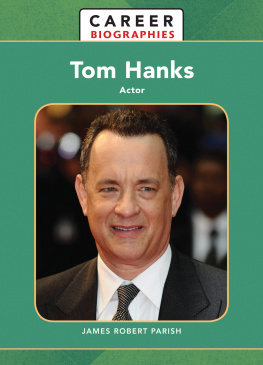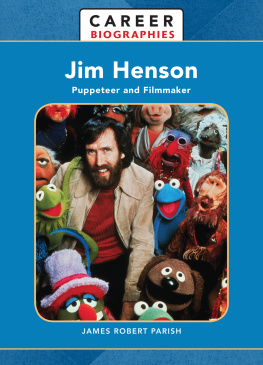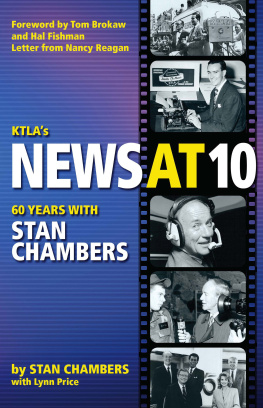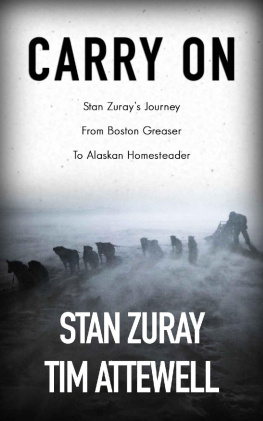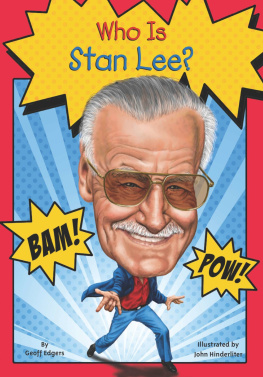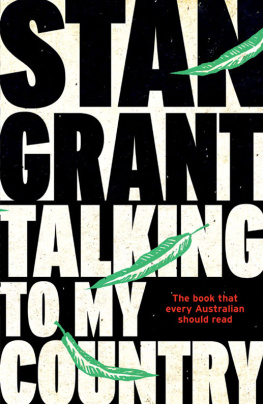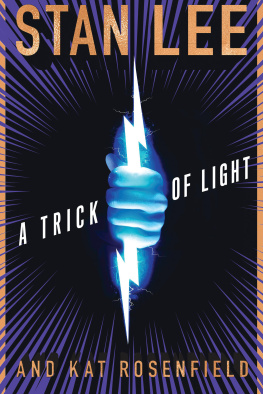James Robert Parish - Stan Lee: Comic-Book Writer and Publisher
Here you can read online James Robert Parish - Stan Lee: Comic-Book Writer and Publisher full text of the book (entire story) in english for free. Download pdf and epub, get meaning, cover and reviews about this ebook. year: 2013, publisher: Infobase Publishing, genre: Humor. Description of the work, (preface) as well as reviews are available. Best literature library LitArk.com created for fans of good reading and offers a wide selection of genres:
Romance novel
Science fiction
Adventure
Detective
Science
History
Home and family
Prose
Art
Politics
Computer
Non-fiction
Religion
Business
Children
Humor
Choose a favorite category and find really read worthwhile books. Enjoy immersion in the world of imagination, feel the emotions of the characters or learn something new for yourself, make an fascinating discovery.
- Book:Stan Lee: Comic-Book Writer and Publisher
- Author:
- Publisher:Infobase Publishing
- Genre:
- Year:2013
- Rating:5 / 5
- Favourites:Add to favourites
- Your mark:
- 100
- 1
- 2
- 3
- 4
- 5
Stan Lee: Comic-Book Writer and Publisher: summary, description and annotation
We offer to read an annotation, description, summary or preface (depends on what the author of the book "Stan Lee: Comic-Book Writer and Publisher" wrote himself). If you haven't found the necessary information about the book — write in the comments, we will try to find it.
The life and career of Stan Lee,
Stan Lee: Comic-Book Writer and Publisher — read online for free the complete book (whole text) full work
Below is the text of the book, divided by pages. System saving the place of the last page read, allows you to conveniently read the book "Stan Lee: Comic-Book Writer and Publisher" online for free, without having to search again every time where you left off. Put a bookmark, and you can go to the page where you finished reading at any time.
Font size:
Interval:
Bookmark:
Copyright 2013 by Infobase Learning
All rights reserved. No part of this publication may be reproduced or utilized in any form or by any means, electronic or mechanical, including photocopying, recording, or by any information storage or retrieval systems, without permission in writing from the publisher. For more information, contact:
Chelsea House
An imprint of Infobase Learning
132 West 31st Street
New York NY 10001
ISBN 978-1-4381-4590-7
You can find Chelsea House on the World Wide Web
at http://www.infobaselearning.com
In May 2002 the live-action film Spider-Man burst onto 3,615 North American movie screens. Within months the film would make more than $800 million. The film led to the successful sequel Spider-Man 2 (2004) and plans for Spider-Man 3 (2007), a wide array of Spider-Man clothes and toys, and other products. The huge success of the film also proved what Spider-Man's creator, Stan Lee, had been insisting upon for decades: The world has an enduring fascination with superheroes. Back in the early 1960s, Lee co-created some of the most famous and extraordinary comic-book characters, including Spider-Man, The Fantastic Four, The Hulk, Thor, Iron Man, Daredevil, Dr. Strange, and many others. By then Lee had already spent more than 20 years in the comic-book industry as an editor, writer, and art director at one of the industry's prime publishers, Timely (later Marvel) Comics.
The characters Lee created were unlike any that comic-book readers had ever seen. The Fantastic Four, for example, who first appeared in 1961, were different from traditional costumed superheroes such as Superman, Batman, and Wonder Woman. Whereas these other heroes were extremely well-adjusted and had few personal problems, Lee's Fantastic Four had human flaws. Readers could easily identify with this new breed of crusaders who boasted fabulous crime-fighting superpowers, but who were often weighed down with personal problems that distracted them from protecting the public. Almost overnight, Lee's innovative idea of presenting superheroes with failings boosted the sagging comic-book industry and helped bring about its "Silver Age" of success. As comic-book historian Robert Harvey pointed out in The Art of the Comic Book: An Aesthetic History (1996): "Nearly all modern superhero comics have drawn and continue to draw on the first 80 or so issues of The Fantastic Four for inspiration and material."
Over the next several years, Lee turned out a wide assortment of popular superhero comic books. Lee collaborated with several talented artists who illustrated his concepts within the comic-book panels (the individual boxes that frame the drawings of each story-line step). It was Lee, however, who dreamed up the array of amazingly colorful personalities who inhabited these comic books, and it was he whoin the initial yearsprovided all of the dialogue.
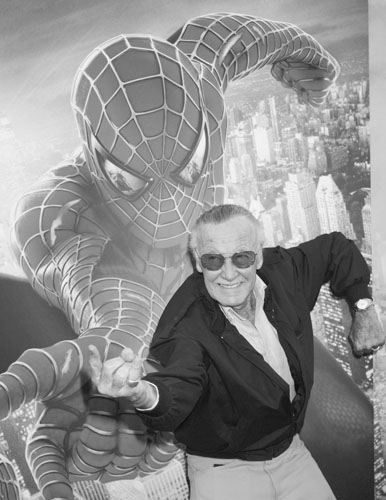
Stan Lee is the creator of Spider-Man and other famous comic-book characters.
Source: Landov.
In the 1960s Stan Lee created the characters that would make up the "Marvel Universe." In that world, heroes such as Spider-Man protected New York City and other metropolises from sinister forces bent on world domination.
Not content to rest on his laurels, Lee (known to his fans as "Stan the Man" and "Mr. Marvel") went on to become publisher of Marvel Comics in 1972. Still later, he became the firm's key spokesperson and goodwill ambassadora post he actively continued for many years. Having begun in the business in 1940, over the decades Lee experienced the industry's many financial ups and downs and shifting trends. Despite the swings in popularity and changing fortunes of the comic-book profession, Lee has always remained highly enthusiastic about the medium through which he captured the imagination of generations.
From his beginnings in the comic-book field right through his professional heyday in the 1960s and thereafter, Stan Lee had one guiding principle: "I tried to write stories that would interest me. I'd say, what would I like to read? Then I'd try to write them clearly enough so that a youngster could enjoy and appreciate and understand the story, and I tried to write them intelligently enough so that an older person would enjoy it too." He adds, "I know what I like, and I can't believe I'm so unique. If I could write a story that really pleases me, there must be millions of people who have the same taste I do. So if I like it, there'll be a lot of other people who like it. And I've always used that rule."
Stanley Martin Lieber was born in New York on December 28, 1922, the first child of Jack and Celia (Solomon) Lieber. His parents were Jewish-Romanian immigrants. Jack worked as a dress cutter in the city's garment industry. When the Great Depression choked the U.S. economy in the late 1920s, Jack lost his job and could find no new employment. The family was forced to move from their comfortable Manhattan apartment to a cramped little place in the Bronx.
In these tiny new quarters Stanley had to sleep in the living room. This did not bother him as much as the fact that the family's new apartment looked out on the side of another building. As the future celebrity recalled, "My dream was to one day be rich enough to have an apartment that faced the street." When Stanley was eight, his second and only sibling, Larry, was born. Because there was such an age gap between the brothers, they were not close in their younger years. But later in life they would work side by side in the comic-book industry.
During Stanley's early years, his parents constantly arguedusually over money matters. Despite Jack's best efforts, the bright man was unable to find steady employment. As a result the family often had to rely on financial help from Celia's sisters, who were weathering the Depression better than the Liebers. This situation was humiliating for Jack, and he channeled some of his frustration into his relationship with his sons. In contrast, Celia was warm and encouraging to her children.
To escape the household arguments and the general gloom of the Depression, young Stanley found great pleasure in reading. He graduated from reading the Hardy Boys adventures and the works of Mark Twain (author of, among others, The Adventures of Tom Sawyer and The Adventures of Huckleberry Finn), Edgar Rice Burroughs (the creator of Tarzan), and Sir Arthur Conan Doyle (the author of the Sherlock Holmes detective tales) to reading Shakespeare before he was 10 years old. He would later remember, "I didn't understand a lot of it in those days but I loved the words. I loved the rhythms of the words." He often read books to his adoring mother and also enjoyed reading the newspaper comic strips of the era, especially "Krazy Kat" and "They'll Do It Every Time."
Besides his growing love of literature, Stanley loved to scribble "little illustrated stories to amuse myself. I would draw a straight horizontal line for the horizon and then add stick figures above it, around which I built simple stories and plot lines. I was, without knowing it, creating my first comicbooks. This was a make-believe world I loved because I could retreat to it from the outsideparticularly from school."
Stanley also loved going to the movies when he could scrape together the pennies for admission. There he reveled in the big-screen westerns, detective stories, and swashbuckling heroes of the day. "There on the screen were worlds that dazzled my mind," he says, "worlds of magic and wonder, worlds which I longed to inhabit, if only in my imagination." Then too, Stanley was excited by the animated cartoon short subjects he saw, especially the work of Walt Disney and his most famous cartoon creation, Mickey Mouse. In fact, Stanley was so inspired by Disney's animation output that it prompted the future comic-book king to say, "I admired him so when I was a kid. I probably created many more characters, but he created an empire. I'm not an empire creator."
Font size:
Interval:
Bookmark:
Similar books «Stan Lee: Comic-Book Writer and Publisher»
Look at similar books to Stan Lee: Comic-Book Writer and Publisher. We have selected literature similar in name and meaning in the hope of providing readers with more options to find new, interesting, not yet read works.
Discussion, reviews of the book Stan Lee: Comic-Book Writer and Publisher and just readers' own opinions. Leave your comments, write what you think about the work, its meaning or the main characters. Specify what exactly you liked and what you didn't like, and why you think so.

